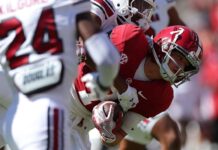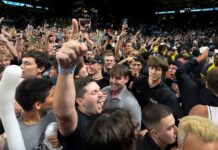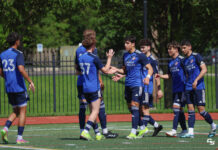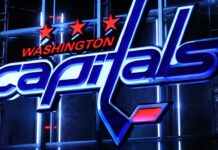[ad_1]
The future structure of major college sports is beginning to come into sharper focus.
Proposed details of how college athletes will be paid in the future were revealed Friday evening in a sprawling Northern California court filing. The changes are part of a pending legal settlement that will resolve a trio of antitrust lawsuits filed against the NCAA and its five richest conferences.
The proposed settlement has two main functions. First, former athletes (dating to 2016) are eligible for a share of the $2.78 billion in compensation. Second, the terms structure direct payments to players, along with rules designed to prevent wealthy schools from gaining a greater competitive edge than they already have.
To help digest the 100-plus pages of legal filings, we’ve broken down what we know about the settlement into 10 questions about what it could mean for athletes, schools and fans.
When will players start getting paid?
If all goes according to plan, college athletes will be getting paid by their schools by this time next year.
The settlement still has to be approved by a judge, and it will take months for current college athletes to learn what it means and whether they want to object to any terms.
The tentative schedule looks like this:
Early October: Athletes begin to receive details on how the settlement will affect them.
Mid January: Deadline for athletes to submit any objections or opt out.
Mid March: Judge Claudia Wilken made the final ruling on the settlement.
Summer 2025: Schools began signing contracts with athletes.
How much do schools pay their players?
Initially, schools would be able to spend a maximum of $23.1 million in additional funds, according to estimates shared in the terms of the settlement. This is in addition to tuition, stipends and other benefits schools already provide to players each year.
The new revenue sharing payments will come in the form of contracts where schools purchase the rights to use their athletes’ names, likenesses and likenesses (NIL). Schools don’t have to spend any money, but most athletic departments in power conferences are expected to approach the limit to stay competitive in recruiting.
The cap will increase on an annual basis during the 10-year long settlement agreement. The number automatically increases by 4% per year. As the revenue generated by college sports grows, so will it. An economist hired by the plaintiffs’ attorneys estimated the cap would increase by roughly $1 million per year, ending at $32.9 million per school in the 2034-35 school year.
How did the parties land on $23.1 million?
The spending limit is based on a formula that pays athletes 22% of what power conference schools make from media rights contracts, ticket sales and sponsorships. The formula does not include money that athletic departments earn by collecting fees from the general student body or from donations.
Athletes in the major American pro sports leagues receive about half of their sports earnings. Lawyers for both the NCAA and the plaintiffs said that when combined with the money the schools already spend on scholarships, medical care and other benefits, the 22% revenue share figure would give athletes at many power conference schools about half of what the athletic departments make. on an annual basis.
However, this formula treats all athletes the same, even though football and basketball bring in the bulk of an athletic department’s revenue. There were a dozen football teams that reported more than $100 million in revenue of their own last season. Even if the players on those teams received every dollar of the new revenue sharing money — and they won’t — those athletes would still receive less than half of what they’re making.
How will this money be divided among the athletes?
Each school will be able to decide how to divide its money among athletes.
It’s unclear how Title IX law will apply to the money, and the terms of the settlement provide no guidance in that regard. TCU basketball player Sedona Prince — one of the lead plaintiffs in the lawsuit and a prominent advocate for gender equality during her college career — told ESPN she thinks any increase in scholarships or medical benefits should be split equally between men and women, but that revenue shares dollars for a sport’s popularity. should be distributed based on.
“I think we should play sports,” Prince said. “Title IX has closed so much of the gap. It’s a necessity in college sports and college life in general. But the fact is. College football makes a lot more money than the rest of the sport.”
Prince said he hopes athletes on each campus will be able to be part of the discussion when their schools decide how much money they will spend and how to divide it among athletes. He is working with a group called Athletes.org that is trying to organize athletic chapters on many college campuses to help them negotiate with their schools on a number of items, including a say in how the new revenue sharing money will be distributed.
Will the NIL collectives still be able to pay the athletes?
Over the past three years, most of the money college athletes have earned has come from NIL collectives — groups of boosters who are ostensibly paying players for their NIL rights, but in practice are using that money to pay players for their performance. According to industry sources, the best-paid conglomerates are paying out between $15 million and $20 million a year, and the vast majority goes to football players.
The NCAA negotiated to include several conditions in the settlement in hopes of ending collective payments that are not for actual sanctioning. Along with a clause that says booster payments to athletes must be for “a legitimate business purpose,” the settlement empowers the NCAA to create future rules to close any unintended loopholes “designed to defeat or circumvent” the ban on booster payments.
Associations will be able to pay players NIL if the NCAA deems them to be valid sanction compensation. The settlement states that the association will create a clearinghouse to collect information on all NIL contracts to help them assess which ones are legitimate.
College sports attorneys not involved in the settlement and NIL joint operators are skeptical that the NCAA will be able to effectively (and legally) prevent boosters from spending money aimed at making their teams better.
How will these new rules be implemented?
The terms of the settlement put the court in charge of ensuring that all parties comply with the new rules. The court may appoint a special arbitrator to adjudicate any dispute. The settlement creates an appeals system for athletes or schools to ask an arbitrator to review future decisions about these new rules. This would be a significant departure from the current enforcement system run by NCAA employees.
The plaintiffs’ attorneys — Steve Berman and Jeffrey Kessler — will be responsible for making sure the schools are accurately reporting their revenue in the 10-year agreement. They will also be responsible for communicating with college athletes throughout that time to ensure that schools honor the contract and that incoming athletes understand their rights. The terms of the settlement say the lawyers can rely on advocacy groups like the National College Players Association and Athletes.org to represent the athletes’ point of view.
What about walk-ons and scholarships?
In the interest of removing as much of the universal cap on compensation as possible, the NCAA and conferences agreed to get rid of current rules that limit the number of scholarships allowed for each team. To keep wealthy teams from stockpiling players, the NCAA would instead create rules that limit roster size.
The settlement terms include fixed roster limits for 45 different sports. Football teams will be limited to 105 players on a roster. Men’s and women’s basketball teams can each have 15 players.
Current NCAA rules limit football teams to 120 players per season, and only 85 of them can receive scholarships. In the future, 105 players on the team will be able to receive a scholarship. While schools are not required to offer all players scholarships, many coaches expressed concern this summer that the new rule would eliminate walk-ons. Each school will determine how many players they will award scholarships to.
What if the athletes decide they don’t like the terms of the settlement?
This fall all athletes will have the opportunity to object to certain terms or opt out entirely. If they opt out, they retain the right to sue the NCAA for other alleged antitrust violations in the future. The terms state that if a certain number of athletes decide to opt out, the NCAA and conferences can back out of the settlement. The number of athletes required to trigger that option was revised in the public version of the document.
Prince, who spoke to ESPN before seeing the details of the settlement, said he trusted Berman and Kessler to negotiate the best possible terms for the athletes, but added that he would look at the information critically and make other “checks and “Balance” will depend on it. He feels that the result is a fair deal for the athletes. Prince said the coming year is an important time for athletes to be vigilant and make sure they have a say in how the framework provided in the deal is implemented.
“For athletes, it’s time to wake up and get educated,” he said. “It’s going to be better for the NCAA as well if we all come together and work together for us. I hope they understand that. I hope the athletes understand that. It’s time for us to step up and join in. It’s Get out, or it’s going to be the same (legal battle) over and over again.”
The agreement also states that the terms of the contract do not prevent the athletes from collectively bargaining for more rights in the future if that opportunity arises.
Who gets a share of the $2.78 billion loss?
In addition to future payments to athletes, the NCAA has agreed to compensate former athletes for money they otherwise would have made during their careers. All athletes who played Division I sports from 2016 to the present are eligible to receive some of that money. The 2016 cutoff date is due to the statute of limitations on antitrust claims.
Football and men’s basketball players at power conference schools will be eligible to receive an average of $135,000, Berman said. Women’s basketball players from power conferences can earn an average of $35,000. Potential payouts for athletes in other sports will depend on how many enter the claim.
For some, payouts will also be based on the athlete’s potential earning power if they are able to sign a NIL contract while in school. Berman said the highest individual estimated payout for an athlete would be $1.8 million.
The law firms of Berman and Kessler also requested about $500 million (a little less than 20 percent of the damages) to cover their fees and costs. Advocates have proposed that schools receive about 1 percent of what they pay players over the next 10 years. According to the settlement estimates, it will cost lawyers an estimated $12 million to $25 million per year.
Does this mark the end of the NCAA’s legal troubles?
no The NCAA is still involved in multiple court battles to prevent athletes from being considered employees of their schools. NCAA leaders have asked members of Congress to write a federal law codifying the authority to make certain rules that include college athletes not employees and settlements.
NCAA President Charlie Baker said earlier this summer that he hoped the settlement would provide momentum for a federal bill.
[ad_2]











